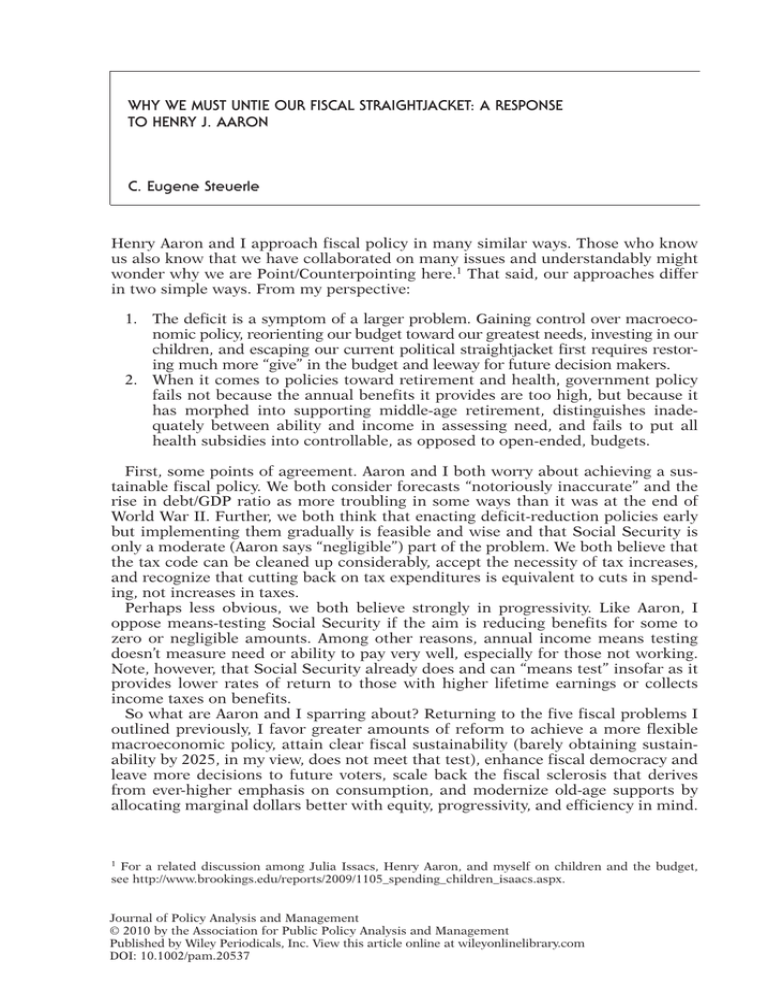Henry Aaron and I approach fiscal policy in many similar... us also know that we have collaborated on many issues... WHY WE MUST UNTIE OUR FISCAL STRAIGHTJACKET: A RESPONSE
advertisement

WHY WE MUST UNTIE OUR FISCAL STRAIGHTJACKET: A RESPONSE TO HENRY J. AARON C. Eugene Steuerle Henry Aaron and I approach fiscal policy in many similar ways. Those who know us also know that we have collaborated on many issues and understandably might wonder why we are Point/Counterpointing here.1 That said, our approaches differ in two simple ways. From my perspective: 1. The deficit is a symptom of a larger problem. Gaining control over macroeconomic policy, reorienting our budget toward our greatest needs, investing in our children, and escaping our current political straightjacket first requires restoring much more “give” in the budget and leeway for future decision makers. 2. When it comes to policies toward retirement and health, government policy fails not because the annual benefits it provides are too high, but because it has morphed into supporting middle-age retirement, distinguishes inadequately between ability and income in assessing need, and fails to put all health subsidies into controllable, as opposed to open-ended, budgets. First, some points of agreement. Aaron and I both worry about achieving a sustainable fiscal policy. We both consider forecasts “notoriously inaccurate” and the rise in debt/GDP ratio as more troubling in some ways than it was at the end of World War II. Further, we both think that enacting deficit-reduction policies early but implementing them gradually is feasible and wise and that Social Security is only a moderate (Aaron says “negligible”) part of the problem. We both believe that the tax code can be cleaned up considerably, accept the necessity of tax increases, and recognize that cutting back on tax expenditures is equivalent to cuts in spending, not increases in taxes. Perhaps less obvious, we both believe strongly in progressivity. Like Aaron, I oppose means-testing Social Security if the aim is reducing benefits for some to zero or negligible amounts. Among other reasons, annual income means testing doesn’t measure need or ability to pay very well, especially for those not working. Note, however, that Social Security already does and can “means test” insofar as it provides lower rates of return to those with higher lifetime earnings or collects income taxes on benefits. So what are Aaron and I sparring about? Returning to the five fiscal problems I outlined previously, I favor greater amounts of reform to achieve a more flexible macroeconomic policy, attain clear fiscal sustainability (barely obtaining sustainability by 2025, in my view, does not meet that test), enhance fiscal democracy and leave more decisions to future voters, scale back the fiscal sclerosis that derives from ever-higher emphasis on consumption, and modernize old-age supports by allocating marginal dollars better with equity, progressivity, and efficiency in mind. 1 For a related discussion among Julia Issacs, Henry Aaron, and myself on children and the budget, see http://www.brookings.edu/reports/2009/1105_spending_children_isaacs.aspx. Journal of Policy Analysis and Management © 2010 by the Association for Public Policy Analysis and Management Published by Wiley Periodicals, Inc. View this article online at wileyonlinelibrary.com DOI: 10.1002/pam.20537 2 / Point/Counterpoint The inaccuracy of forecasts adds risks—it doesn’t subtract from them—and it compels us to leave future taxpayers more flexibility, not less. An IMF report cites nine examples of nations that reduced deficits by more than 10 percentage points and a related 24 examples of nations that dropped debt-toGDP ratios by 10 to 70 percentage points in 5 to 16 years. While Aaron would make the debt-to-GDP ratio, not deficits, the policy target, he’s happier than I am about waiting at least 15 more years to make a dent. As he puts it, “aiming to stabilize the debt/GDP ratio before 2025 implies budget shifts so large . . . that they could threaten economic recovery.” From a macroeconomic standpoint, on the heels of a decade of movement toward higher levels of deficit, we’re already less able to respond with adequate stimulus to the next recession—a dangerous path, whatever the politics. Moreover, if the economic recovery is well underway by 2012, the evidence from large fiscal adjustments in other countries is that significant fiscal adjustments do little damage and can even help economic growth. Aaron’s microeconomic argument is at least partly political: Members of Congress, he states, take a “quite understandable position” in “show[ing] themselves unwilling to make large changes in Social Security or Medicare affecting those who . . . are over age 45 to 55.” Yet the number of Americans over age 45, while currently about equal in number to those aged 16 to 45, is expected to grow twice as fast between 2010 and 2030 (plus 35 million vs. plus 16 million, or 29 percent vs. 14 percent). Meanwhile, the lifetime value of Social Security and Medicare is expected to grow from about $750,000 for a typical couple who retired in 2000 to more than $900,000 for the couple retiring in 2010, to about $1.4 million for the 45-year-old couple hitting 65 in another 20 years. Moreover, those over age 45 benefit hugely from: (1) past tax cuts, (2) the deficits that financed their consumption during the recent recession, (3) built-in growth rates for their benefits, (4) longer lives, (5) better health care, and (6) Social Security and Medicare taxes combined that are low relative to the benefits they receive. I understand the politics of Aaron’s argument. But no economic principle— progressively basing benefits relative to taxes on ability or need, growth, efficiency, or anything else—supports the conclusion that those who will benefit most from recent developments should shift virtually all of the associated costs onto the backs of younger workers. Aaron does support tax increases, covered partly by those over age 45. A valueadded tax is one example, but among those hit by that tax are those who become disabled and the very old. But why, then, exclude benefit alternatives? For instance, bumping up the retirement age mainly asks those with about 20 years of life expectancy to work a little longer and wouldn’t hit the disabled, the very old, and families during child-raising years. Keep in mind that the type of benefits shift I support—though limiting the number of years of middle-age retirement support and lowering the benefit growth rate for some—would yield higher average lifetime benefits for most of the bottom economic third or half of the elderly population (Butrica, Smith, & Steuerle, 2006). That’s partly because I’d reallocate future benefit growth. Most important, if we can slow the scheduled decline in employment rates (see Johnson, Mermin, & Steuerle, 2006), then we will get more output, revenues, and available spending without further tax rate increases or benefit rate cuts (Steuerle & Rennane, 2010). A final issue warranting far more discussion is whether we know enough to constrain the growth in health costs. I think we know what not to do: leave health programs without real budget constraints. While better knowledge will inform us, budget constraints will push us to adopt potential improvements in health benefits relative to costs. Journal of Policy Analysis and Management DOI: 10.1002/pam Published on behalf of the Association for Public Policy Analysis and Management Point/Counterpoint / 3 To make fiscal policy more stable and flexible, to invest better in our future and our children, and to reduce the economic dangers that current policies portend, we must act soon. Done right, we can also enjoy greater progressivity and leave future decision makers more leeway. Internationally, the U.S. must lead; it can’t rely upon a worldwide slowdown to keep our interest rates low. Aaron in the end may be right about what our politicians will be willing to do, but I deeply fear the potential economic fallout of starting from that base. REFERENCES Butrica, B. A., Smith, K. E., & Steuerle, C. E. (2006). Working for a good retirement. Retirement Project Discussion Paper 06-03. Washington, DC: Urban Institute. Johnson, R. W., Mermin, G., & Steuerle, C. E. (2006). Work impediments and older ages. Retirement Project Discussion Paper 06-02. Washington, DC: Urban Institute. Steuerle, C. E., & Rennane, S. (2010). Social Security and the budget. Retirement Policy Program Brief 28. Washington, DC: Urban Institute. Journal of Policy Analysis and Management DOI: 10.1002/pam Published on behalf of the Association for Public Policy Analysis and Management

